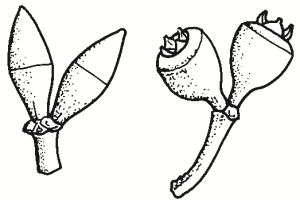Family:
Myrtaceae
Eucalyptus dealbata
Tumbledown Gum
Other Names: Tumbledown Red Gum, Blakely's Red Gum, Silver Gum.
First Nations Name(s):

Name Origin:
dealbata — meaning white-ashed, referring to hue on leaves, particularly in autumn.
Regional Subspecies:
Similar Species:
Resembles Blakely’s Red Gum (E. blakelyi), particularly on better sites. Distinguished from Dwyer’s Red Gum (E. dwyeri) by its wider leaves, especially in seedlings. ???See Practical Information Note — The Red Gum Story. ???
Occurrence:
Regional:
Usually on dry rocky hills. Noted in the following areas: Urana-Rand-Corowa; Long Plain- West Hume; Majors Creek; Burrumbuttock-West Hume; Deadmans-Bungowannah-Long Flat; Albury district; Yambla; Mountain Creek-Native Dog-Sandy Creek; Sawyers-Forest-Four Post & Little Billabong; Boree; Narrandera-Morundah-Galore-Collingullie; Coreinbob & Carabost.
Australia:
Qld, NSW, Vic.
Habitat:
Grassy woodland on skeletal soils, usually on basic rocks. Also with White Cypress Pine (Callitris glaucophylla).
Habit:
Straggly tree to 15 m high with smooth bark shedding in large plates or flakes. Narrow grey- green adult leaves. Varies in form depending on site quality. More mallee-like on poorer sites.
Site Preference:
Tolerates most frost and dryness once established.
Flowering:
White, winter to early summer.
Propagation:
From seed.
VALUES:
Shade & Shelter:
Useful medium-level cover in windbreaks.
Land Protection:
Useful for recharge plantings.
Wildlife:
Birds attracted to good supplies of nectar and pollen. Hollows are nesting and refuge sites for many native birds and mammals.
Timber:
Durable in ground. Suitable for fencing and heavy construction, although trees often crooked. Potential for woodlot planting.
Ornamental:
Decorative specimen for larger gardens and parks. Saplings develop crown of attractive broad silvery leaves.
Other:
Very important in NSW due to pollen production for apiculture.
